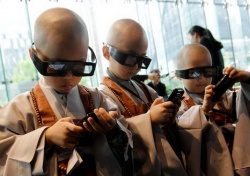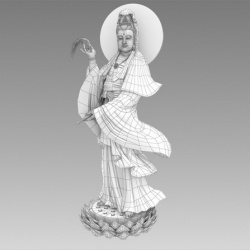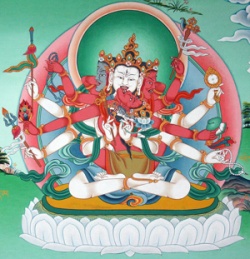Shakyamuni Buddha spoke the Amitabha Sutra
By Bhikshuni Heng Yin
Buddhist Text Translation Society
June 25, 1974.
Shakyamuni Buddha spoke the Amitabha Sutra to let all oving beings know of the power of Amitabha Buddha’s great vows to lead all who recite his name with faith to rebirth in his Buddhaland, the Land of Ultimate Bliss, where they may cultivate and quickly realize Buddhahood.
Of the five great schools of Buddhism – the Ch’an (Zen) School, the Teaching School, the Vinaya School, the Secret School, and the Pure Land School – the Pure Land Dharma door of Buddharecitation is the most suited for living beings of the Dharma-ending Age, when beings are beset by external disasters and internal obstacles. It is extremely direct and encompasses beings of all dispositions.
For a true understanding of the Amitabha Sutra, the explanation of the Venerable Master Hsuan Hua is indispensable. In the fall of 1969, the Master delivered a series of lectures to his American disciples, brilliantly revealing the essence of the Pure Land Doctrine and causing his American listeners to bring forth deep and sincere faith in the practice of the Pure Land. The lectures were tape-recorded and have now been transcribed so that students of the Dharma everywhere may study them, put them into practice, and thus be filled with the joy of Dharma.
The Venerable Master Hua, through the power of his vows and vast compassion, has come to the West, carrying the mind-seal of all Buddhas as it has been passed in succession from Shakyamuni buddha, through Patriarch Bodhidharma, the Great Master the Sixth Patriarch Hui Neng, through the Venerable Master Hsu Yun who in turn transmitted the Dharma to the Venerable Master Hua. Thus, the Master is the 46th Patriarch from Shakyamuni Buddha, the 18th Patriarch in China from Bodhidharma, the Ninth Patriarch of the Wei Yang Lineage, and the First Patriarch in the West. Although many claim that this is the Dharma-ending Age, the Master upholds the Orthodox Dharma, having founded Gold Mountain Monastery in San Francisco where that Dharma is taught and practiced. ([[Under the Master’s guidance, many young Americans have left the home-life; twelve of them have received complete ordination as Bhikshus and Bhikshunis, forming the first organized Sangha in the western world.]]) The Master has said, “I have come to America to create living Bodhisattvas, living Buddhas, and living Patriarchs.” Thus he has established the Gold Mountain Doctrine, which his disciples reverently uphold: Freezing, we do not scheme.
Starving, we do not beg.
Dying of poverty, we ask for nothing.
We accord with conditions, but do not change. We do not change, yet accord with conditions. These are our three great principles.
We renounce our lives to do the Buddha’s work. We shape our lives to be capable of making revolution in the Sangha Order. In our actions we understand the principles, So that our principles are revealed in our actions. We carry out the pulse ofthe Patriarch’s mind-transmission.
If you wish to comprehend the profound principles found within the Sutras, it is essential that you attend Dharma Assemblies and hear the Sutras explained by qualified teachers. The Venerable Master Hua’s untiring vigor in lecturing on the Dharma is unmatched. He has resolved that as long as he has a single breath of air, he will continue to elucidate the Sutras, regardless of how many people come to listen. If there is only one person, or when there are hundreds, he lectures just the same. At Gold Mountain Monastery, the Dharma is explained every day, seven days a week, 365 days a year. Such intensive lecturing is unparalleled in the entire history of Buddhism in the world.
On June 17th, 1968, at the Buddhist Lecture Hall in San Francisco, the Master began a series of lectures on the Shurangama Sutra to a group of 40 university students during a 96-day Sutra Study and Meditation Session. Each lecture took a minimum of two hours to deliver and translate. When it became evident that the Sutra was too long to finish on schedule, the Master began lecturing twice a day, once in the afternoon and once in the evening, and then three times a day, adding a lecture in the mornings. Finally, by the end of the summer, the Master was lecturing four times a day. The session ended on September 22nd, 1968.
Following the Shurangama Sutra session, the gathering of disciples great steadily. Many who had come from Seattle, Washington to attend the session took up permanent residence in San Francisco, drawn like filings to a magnet to the forthcoming Lotus Sutra assembly which formally began November 10th, 1968. The Master delivered lectures nightly on the Sutra. Two years, and over 350 lectures later, the assembly was concluded on November 10th, 1970.
Shakyamuni Buddha taught the Dharma for 49 years, in over 300 Dharma Assemblies, and left limitless Dharma treasures in the world. He taught 84,000 Dharma doors to counteract men’s 84,000 kinds of afflictions. The Master has labored to expose students to
the fullest possible range of the Buddha’s teaching. Thus, on November 16th, 1968, he began expounding the Sutra of the Past Vows of Earth Store Bodhisattva at weekly Saturday afternoon lectures which continued regularly until September 22nd, 1969. At the request of his disciples, the Master also began lecturing the Diamond Sutra weekly on sunday afternoons. The series ran from November 17th, 1968 to April 6th, 1969. No sooner had he finished lecturing the Diamond Sutra, than he agreed to explain the Heart Sutra with his Verses Without a Stand. That series ran from April 20th, 1969 to July 27th, 1969. As soon as the Heart Sutra assembly was concluded, many eager disciples requested an explanation of the Great Compassion Heart Dharani Sutra which began on August 3rd, 1969 and ended on January 18th, 1970. The second annual Summer Session began on June 16th, 1969. During the session the Master lectured daily in the afternoons on the Chapter on the Conduct and Vows of Samantabhadra, from the Avatamsaka Sutra, in addition to nightly lectures on the Dharma Flower Sutra.
When the Chapter was finished on July 25th, 1969, he then explained the Sixth Patriarch’s Dharma Jewel Platform Sutra daily from August 4th, 1969 to September 12th, 1969. The Master’s tireless dedication inspired deep faith and unwavering vigor in his disciples. Consequentially five of them went to Asia where they received the full ordination in Keelung, Taiwan, and returned as America’s first Bhikshus and Bhikshunis. In their absence the Dharma Flower Sutra lectures were replaced by nightlylectures on the Amitabha Sutra which ran from October 29th, 1969 to December 25th, 1969. Dharma Flower Sutra lectures resumed in January, 1970, after one of the numerous intensive Ch’an Meditation and Buddha Recitation Sessions hosted by the Master at which he delivered lively and informative talks daily. The number of disciples continued to grow. Between May 17th and June 7th, 1970, the Master delivered lectures on the Shastra to the Door of Understanding the Hundred Dharmas. The third annual
Summser Session in 1970 revolved around lectures on the Dharma Flower which continued until autumn when the Assembly came to a close. At that time the Great Hundred Day Meditation Session was inaugurated. The session consisted of fourteen straight weeks of Ch’an meditation, from three o’clock in the morning until twelve midnight, beginning on November 15th, 1970. The Master delivered nightly lectures on the Records of Eminent Monks (kao seng chuan) along with meditation instruction. As usual, the Master continued to lecture in the afternoons on weekends, making a total of nine lectures a weekly. During this period the Master also founded Gold Mountain Monastery and supervised its construction. The Sino-American Buddhist Association took up headquarters there. On April 18th, 1971, the Master began weekly Sunday lectures on the Awakening of Faith in the Mahayana Shastra.
On June 13th, 1970, the first day of the fourth annual Summer Session, the Master began lecturing on National Master Ch’ing Liang’s preface to the Great Avatamsaka Sutra. The Master lectured National Master Ch’ing Liang’s prologue to the Avatamsaka as well. Lecturing daily for a year and five months, he finished, 375 lectures later, on November 10th, 1972. On November 12th, 1972, the Master inaugurated the Great Avatamsaka Assembly, and has continued to expound it daily, sometimes as often as nine times a week. To date, he has delivered over 300 lectures on that text.
At the time of this writing the Master’s schedule include nightly lectures on the Avatamsaka, daily lectures on the Vinaya texts, and weekly lectures on the Awakening of Faith. The assembly of disciples, Bhikshus and Bhikshunis, laymen and laywomen, scholars and professionals, who come to listen often number in the hundreds. This is but a brief outline of how the Master has worked with selfless devotion to lay the foundation of the Buddha’s teaching on Western soil.
The Dharma itself has no orthodox, resemblance, or Dharmaending Age; it is living beings who create the distinctions. One who cultivates the Orthodox Dharma lives in the Orthodox Dharma Age and will obtain the orthodox enlightenment. In the Amitabha Sutra, the Buddha says, “Shariputra, if there are people who have already made the vow, who now make the vow, or who are about to make the vow, ‘I desire to be born in Amitabha’s country,’ these people, whether born in the past, now being born, or to be born in the future, all will irreversibly attain Anuttarasamyaksambodhi.” The Master’s commentary presents a most rare opportunity to study the principles of the Pure Land, and those who have faith, who make vows, and who actually practice this Dharma-door are assured of a miraculous response.


